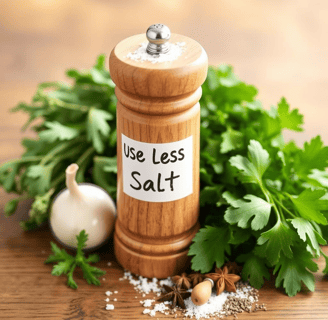Reduce Salt Intake – Helps Maintain Healthy Blood Pressure Levels
🧘WELLNESS TIPSHEART HEALTH & CIRCULATION❤️


High blood pressure, or hypertension, is often dubbed the “silent killer” due to its lack of noticeable symptoms. Globally, it affects millions of individuals and poses a significant risk for heart disease, strokes, and other serious health issues. While various factors contribute to hypertension, scientific evidence consistently highlights salt intake as a crucial aspect that can influence blood pressure levels. Understanding the relationship between salt consumption and hypertension can empower individuals to make informed dietary choices that could significantly impact their health.
The Science Behind Salt and Blood Pressure
Salt, or sodium chloride, is essential for various bodily functions, including maintaining fluid balance, transmitting nerve impulses, and facilitating muscle contractions. However, the human body only requires a small amount of sodium to sustain these vital processes. The Centers for Disease Control and Prevention (CDC) recommends that adults limit their sodium intake to less than 2,300 mg per day—approximately one teaspoon of salt. The American Heart Association (AHA) suggests an even lower limit of 1,500 mg, especially for individuals already diagnosed with hypertension or at risk.
Scientific evidence supports the claim that excessive salt consumption can lead to increased blood pressure. When sodium levels rise in the bloodstream, the body retains more water to dilute the excess sodium, which increases the overall blood volume. As blood volume rises, more pressure is exerted on the arterial walls, leading to hypertension. A study published in the American Journal of Hypertension demonstrated that reducing dietary sodium decreased blood pressure for the majority of participants, particularly those with pre-existing high blood pressure.
The Global Burden of Hypertension
Hypertension continues to be a growing health concern worldwide. According to the World Health Organization (WHO), an estimated 1.28 billion adults aged 30-79 worldwide have hypertension, with the disease being a significant contributor to cardiovascular morbidity and mortality. The increasing prevalence of hypertension is attributed to various factors, including lifestyle choices such as poor diet, lack of physical activity, and smoking. Of these, dietary habits are among the most critical modifiable risk factors—a category in which reducing salt intake plays a pivotal role.
Evidence from Research Studies
Numerous research studies underscore the impact of salt reduction on blood pressure. A meta-analysis published in the British Medical Journal reviewed 34 studies involving over 3,000 participants and found a robust correlation between reduced salt intake and lower systolic and diastolic blood pressure. The analysis confirmed that individuals with hypertension experience more pronounced decreases in blood pressure when they lower their sodium consumption.
Another significant piece of scientific evidence comes from the DASH (Dietary Approaches to Stop Hypertension) study, which focused on the role of diet in hypertension management. Participants consuming a diet rich in fruits, vegetables, whole grains, and low-fat dairy products while reducing salt intake demonstrated significant reductions in blood pressure. The DASH diet emphasizes nutrient-dense foods that provide potassium, magnesium, and calcium—minerals that can help counteract the effects of sodium and promote overall cardiovascular health.
Practical Tips for Reducing Salt Intake
For those looking to maintain healthy blood pressure levels, reducing salt intake can be accomplished through several practical steps:
Cook at Home: Preparing meals at home allows for greater control over ingredients and seasoning. Use herbs, spices, lemon juice, and vinegar as flavorful alternatives to salt.
Read Labels: Many processed foods contain high levels of hidden sodium. Reviewing nutritional labels can help identify products with lower sodium content. Aim for foods labeled "low sodium" or "no added salt."
Choose Whole Foods: Fresh fruits, vegetables, grains, and lean proteins are naturally low in sodium. Incorporating more whole foods into your diet can help reduce overall salt consumption.
Limit Processed Foods: Canned soups, deli meats, frozen meals, and snack foods are often loaded with salt. Opting for fresh or frozen items with no added salt can significantly cut back sodium intake.
Gradual Reduction: Transitioning to a lower-sodium diet can be challenging. Start by gradually decreasing salt in your meals and allowing your taste buds time to adjust to the new flavors.
Understanding Individual Responses
It’s important to note that individuals vary in their sensitivity to sodium. For some, even small amounts of salt can lead to significant increases in blood pressure, while others may tolerate higher levels without notable effects. This phenomenon of "salt sensitivity" indicates the importance of personalized dietary recommendations. Regular monitoring of blood pressure and consultations with healthcare professionals can help individuals determine their specific needs and risks.
The Importance of Holistic Health Approaches
Reducing salt intake is a vital component of managing blood pressure; however, it is not the only factor. A holistic approach to health encompasses a balanced diet rich in nutrients, regular physical activity, weight management, stress management, and sufficient sleep. Each of these elements contributes to optimal blood pressure control.
In summary, scientific evidence consistently demonstrates the link between salt intake and blood pressure levels. By making conscious choices to reduce salt consumption, individuals can take proactive steps toward maintaining healthy blood pressure and, consequently, improving overall cardiovascular health. As our understanding of nutrition and its impact on health deepens, embracing a lower-sodium approach serves not only as a preventative measure against hypertension but also as a means to promote longevity and vitality.
